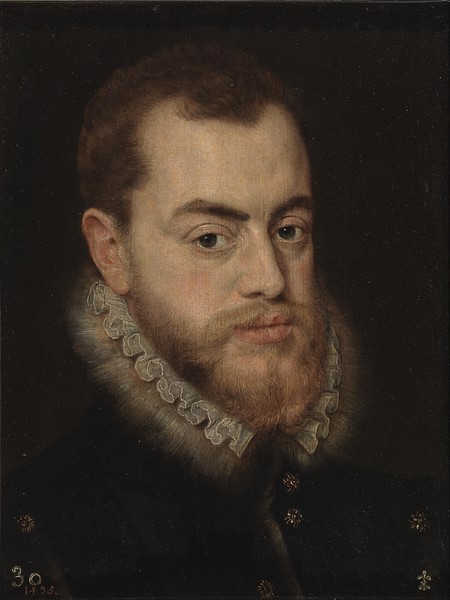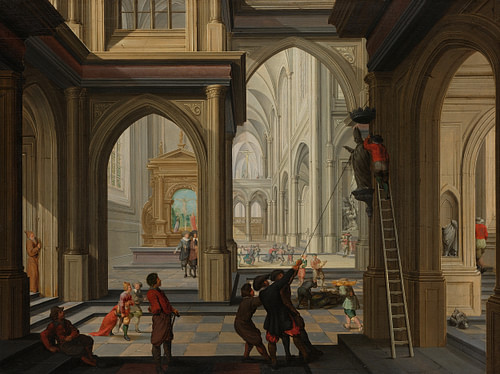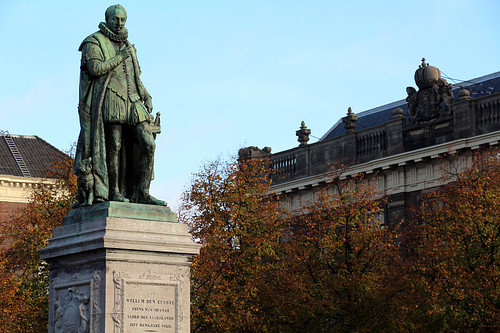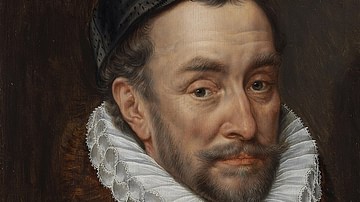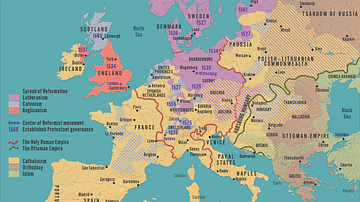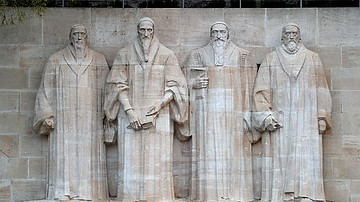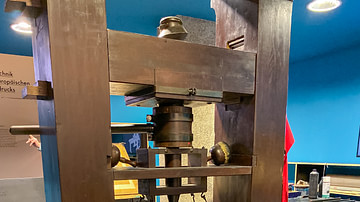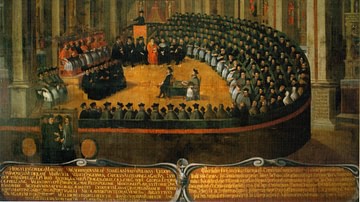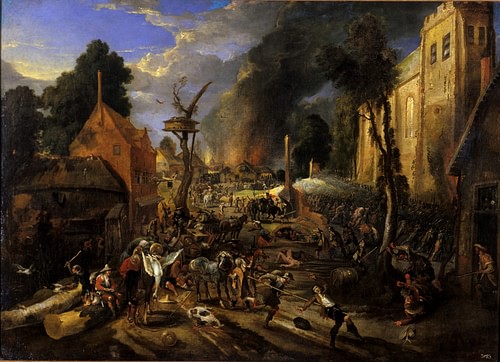
The Eighty Years' War (1568-1648, also known as The Dutch Revolt and Dutch War of Independence) was a military conflict between the seventeen provinces of the Netherlands and Spain, which then governed them, beginning in the reign of King Philip II of Spain (1556-1598). Peace was concluded in 1648 with the establishment of the Dutch Republic.
Results of the war include:
- Beginning of the end of the Spanish Empire
- Portuguese independence as Spain lost hold of its colonies
- Innovations in warfare by Dutch Protestants
- Dutch Independence/formation of the Dutch Republic; countries did not need a monarch
- The Netherlands becomes a major European power; colonization of Americas
The main causes of the war were Philip II's political and religious policies in the Spanish Low Countries (the Netherlands), particularly high taxation and persecution of Protestants. The Protestant Reformation had arrived in the Netherlands through the Anabaptists and then later the Calvinists, and by the 1560s, tensions between Protestants and Catholics were high and increased further by the French Wars of Religion (1562-1598), which encouraged more Protestants to relocate to the Netherlands.
When armed conflict began, Philip II's forces were led by Fernando Álvarez de Toledo, the 3rd Duke of Alba (l. 1507-1582), who had fought for the Catholic cause under Charles V, Holy Roman Emperor (r. 1519-1556) in the Schmalkaldic War (1546-1547). The Duke of Alba took over as Governor of the Netherlands when his repressive religious policies of persecution caused the sitting governor, Margaret of Parma (l. 1522-1586, illegitimate daughter of Charles V), to resign. Alba's policies were challenged by the Protestant William the Silent (l. 1533-1584, also known as William of Orange, not to be confused with William III of England, commonly known as William of Orange) who had fled the duke's persecutions in 1568 and organized the resistance that began the war that same year.
The conflict claimed thousands of lives, including William's, before a truce was called in 1609 (The Twelve Years' Truce), with hostilities resuming in 1621 under Philip II's son – successor to Philip III (r. 1598-1621) – Philip IV (r. 1621-1665), who adhered to the policies of Gaspar de Guzmán, Count-Duke of Olivares (l. 1587-1645), who objected to the significant gains made during the truce by the Dutch statesman Johan van Oldenbarnevelt (l. 1547-1619). By this time, the Thirty Years' War (1618-1648) had begun, which would eventually draw all of Europe into conflict. The Peace of Münster (January 1648) stipulated Dutch Independence but was essentially meaningless until it was included in the Peace of Westphalia (October 1648), ending both the Eighty and the Thirty Years' War.
Although political and social problems contributed to both conflicts, they were informed by religious intolerance, and this was not resolved by the concluding peace. It is for this reason that the conflict is also sometimes referred to as The Dutch Wars of Religion. The divisions caused by the Protestant Reformation (1517-1648) and the Catholic Counter-Reformation (1545-c. 1700) continued in Europe after the wars, informing policy, political agendas, and further conflicts in the 18th century.
Background
Charles V handed control of the Low Countries to his son, Philip II, in 1555 prior to his abdication in 1556. Charles V was a member of the powerful Habsburg family, who were staunch defenders of Catholicism. Charles V had been trying to suppress the 'new teachings' of the Protestants shortly after Martin Luther (l. 1483-1546) introduced them in the Holy Roman Empire in 1517, and, by the 1540s, the Reformation had established itself in the Low Countries first through the Anabaptists (initially a splinter sect of the Reformed vision of Huldrych Zwingli, l. 1484-1531) and then the Calvinists (followers of John Calvin, l. 1509-1564). Philip II was entrusted with not only governing the Low Countries but eradicating the Protestant heresy there.
Philip II was not particularly interested in the Low Countries except as a source of revenue and sent his half-sister Margaret of Parma to govern with the assistance of Emmanuel Philibert, Duke of Savoy (l. 1528-1580) and Cardinal Antoine Perrenot de Granvelle (l. 1517-1586), among others. In 1556, Philip II continued the "Edict of Blood" issued by Charles V in 1550 outlawing Protestant writings, teachings, meetings, and religious services, stipulating among the punishments that males found guilty of heresy were to be put to the sword and females buried alive, or members of either sex to be burned at the stake, and their property confiscated. Granvelle led the Inquisition, which enforced the 1556 edict posted on placards throughout the Low Countries.
Dutch nobles objected to Granvelle's persecutions including William the Silent who, at that time (c. 1559), was Catholic but had been raised Lutheran and supported religious freedom. He was joined by Philip de Montmorency, Count of Horn (l. c. 1525-1568) and Lamoral, Count of Egmont (l. 1522-1568), among others, in calling for Granvelle's recall to Spain, but Margaret of Parma ignored them as she was tasked with eliminating the heresy of Calvinism.
Between 1556-1557, Philip II levied higher taxes on the Low Countries to finance his foreign wars as he was approaching bankruptcy, and in 1559, Granvelle, still running the Inquisition, also reorganized the dioceses in the Low Counties with himself as head, which drew power (and considerable wealth) away from the Dutch nobility and toward Spain. William the Silent, as a stadtholder (administrator) of Philip II, claimed Granvelle had overstepped his authority and was able to have him recalled in 1564. He and Montmorency and Egmont then pressured Margaret of Parma to suspend persecution of Protestants, who had already sent the Belgic Confession of Faith to Philip II in 1562 hoping that an established confession might influence him to change his policies.
Margaret agreed to any efforts that might end religious divisions, but, in 1566, the Calvinists across the Low Countries launched their Beeldenstorm ("statue storm"), also known as the Iconoclastic Fury, during which they destroyed Catholic icons, artworks, monasteries, and churches. Margaret appealed to William the Silent to deal with the issue but, before he could, the Duke of Alba arrived on orders from Philip II to deal with this and other problems. Alba's persecutions of the Protestants were so severe that Margaret of Parma resigned, and William the Silent fled to his hometown of Dillenburg in the Germanic region of the Holy Roman Empire in 1568. Montmorency and Egmont remained and were among the first executed for heresy that same year.
Alba established his Council of Troubles (known to the Dutch as the Council of Blood) to root out heresy and establish order, while William the Silent organized resistance to Spanish rule from Dillenburg and then returned at the head of his troops. On 23 May 1568, the Battle of Heiligerlee was won by Dutch troops led by William the Silent's brothers Louis and Adolf of Nassau, beginning the Eighty Years' War.
War 1568-1579
By this time, the French Wars of Religion had been ongoing for six years, sending Protestant refugees into the Low Countries, but now they were met with Alba's policies of persecution, which then sent both Dutch and French Protestants fleeing elsewhere. Scholar Diarmaid MacCulloch notes:
Alba's punishment of the region lived up to the worst fears inspired in the previous few years: he executed two leading noblemen in 1568, together with about 1,000 others, and the Spanish army behaved like an occupying force in enemy territory. Thousands fled from the Netherlands; it was a highly significant moment for the Reformed as their community in Antwerp, northern Europe's leading center of culture and intellectual enquiry, dispersed across northern Europe to sympathetic refuges in London, Emden, and the German territories. (312)
Alba sent his forces south, leaving northern areas with little protection, and defeated William the Silent in a number of engagements, but in 1572, Elizabeth I of England (r. 1558-1603) expelled the Sea Beggars (independent privateers, known as the Geuzen) from her ports, and they easily took the northern Dutch port of Brill (also given as Brielle) and then that of Vlissingen, establishing Protestant bases and encouraging other cities in the north to declare support for William the Silent.
The Sea Beggars then became an effective military presence, defeating Spanish fleets throughout 1573 and into 1574. At this point, with the war going against Spain (which was running out of money to finance it), Alba was recalled and replaced by Luis de Requesens y Zúñiga (l. 1528-1576) as governor. Requesens abolished the Council of Troubles and negotiated with William the Silent and the other Protestant leaders to end hostilities, but, as Philip II refused to compromise on what he saw as heresy and the Protestants rejected the stipulation that Catholicism was to be universally reinstituted throughout the Low Countries, no peace was possible.
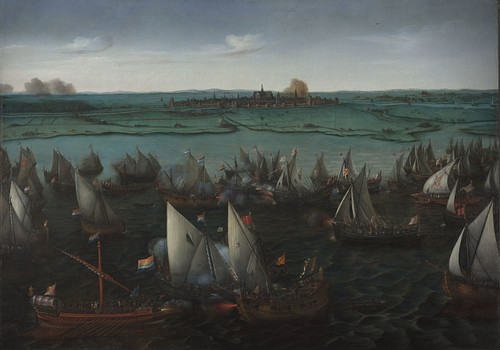
Requesens died in early 1576 and was replaced by John of Austria (l. 1547-1578), Philip II's half-brother, who arrived after the Pacification of Ghent was formalized that November. The Pacification of Ghent, formalized as a response to the mutiny of Spanish mercenary troops who had not been paid in two years and began sacking cities (the Spanish Fury), resulted in their withdrawal from the Low Countries and came close to establishing peace but no agreement on freedom of religion could be reached and so hostilities continued.
John of Austria inflicted a number of devastating defeats on the Protestants before dying of disease in 1578. He was replaced by Alexander Farnese, Duke of Parma (l. 1545-1592) who was as effective a military leader as Alba and John of Austria had been. His victories were primarily in the south, however, and in 1579, the Union of Utrecht was signed, establishing the united northern provinces of the Low Countries as independent of Spain, including Flanders, Friesland, Holland, Utrecht, and Zeeland, among others, which prompted the Treaty of Arras (forming the Union of Arras) in the south, allying provinces including Artois and Hainaut with Parma and the Catholic cause.
Duke of Anjou & Death of William
Attempts at reconciling the parties of the Utrecht and Arras unions failed miserably as no compromise on religion could even be considered. William the Silent, casting about for a suitable monarch to replace Philip II, invited Francis, Duke of Anjou and Alençon (l. 1555-1584), who had been fighting for the Protestants in the French Wars of Religion, to become monarch of the Low Countries, and he arrived in 1582. Francis was the youngest son of Catherine de' Medici (l. 1519-1589) and had been consistently sidelined by his older brothers and sisters. Finding himself in more or less the same situation in the Low Countries, with William the Silent and the States-General having more actual power than he did, he led his troops in an attack on Antwerp in 1583 where they were ambushed and slaughtered (the so-called French Fury). Francis then returned to France in disgrace and William the Silent lost considerable prestige.
Philip II placed a bounty on his head, which encouraged the pro-Spanish Catholic Balthasar Gerard to assassinate him in July 1584. Gerhard was then tortured to death but became a martyr to the Catholics as William did to the Protestants. The States-General now offered the crown to Elizabeth I, but she declined, offering instead a protectorate and sending military aid. Maurice of Orange (l. 1567-1625), William's son, took over as leader, initially supported by Johan van Oldenbarnevelt and others.
The forces of Parma were distracted by the wars in France at this time, giving Maurice the opportunity to reform his armies, implementing new strategies and discipline. Drawing on the military tactics and formations of the ancient Roman army, Maurice reconfigured military units and established the tactic of continual volley fire and countermarch in which a row of infantry would discharge their weapons, split to either side, and head to the rear of the formation while reloading, as the second row fired and did the same. Maurice's innovations are regarded as establishing the paradigm of modern warfare later developed by Gustavus Adolphus of Sweden (l. 1594-1632) in the Thirty Years' War.
Philip II died in 1598 and was succeeded by Philip III, who continued his policies, but now the Dutch armies were better trained and so more effective. Spain had suffered a severe blow in the loss of the Spanish Armada in 1588 during its invasion of England and, at the same time, the united northern provinces had become more firmly established and were able to send naval fleets to attack Spanish interests, diverting resources and manpower away from Spain's efforts in the Low Countries. The Dutch-Portuguese War (1602-1663, also known as the Spice War) further distracted Spain as it tried to hold onto its colonies. Even so, both sides poured money into recruiting troops and building forts which depleted their funds, and the war slowly came to the temporary halt known as the Twelve Years' Truce.
Twelve Years’ Truce & Thirty Years’ War
The truce was largely the work of the statesman Johan van Oldenbarnevelt of Holland (probably best known as the founder of the Dutch East India Company in 1602), ignoring the objections of Maurice of Orange, who was confident he could win the war. Once the truce was called, and the Dutch Protestants no longer had to worry about fighting the Spanish, they turned on each other as liberal and conservative factions tried to gain greater political power. An advocate of religious tolerance, Oldenbarnevelt negotiated the disbanding of armed militia who supported the more radical and conservative elements of the States-General, and under his guidance, Holland declared its independence. He was later arrested under orders of the conservatives (supported by Maurice), along with his supporters, and executed.
During the Twelve Years' Truce, however, Oldenbarnevelt firmly established Holland as a powerful state within the Dutch Republic. The Thirty Years' War began in 1618 when Ferdinand II (l. 1578-1637) was deposed as King of Bohemia and the Dutch Republic supported his successor Frederick V (l. 1596-1632) with arms and resources. The Dutch intervention in Bohemia marked the first entrance of a foreign power into what was initially a civil war and would eventually involve all of Europe.
Philip III of Spain died in 1621 and was succeeded by Philip IV, who relied on the counsel of his prime minister Gaspar de Guzmán. Guzmán objected to the developments in the Low Countries during the truce and, especially, to the rise in Dutch commercial trade at Spain's expense. Hostilities resumed in 1621 after Spain's embargos were established, at Guzmán's suggestion, interrupting shipping and depressing the Dutch economy.
Maurice of Orange died in 1625 and was succeeded by his half-brother Frederick Henry, Prince of Orange (l. 1584-1647). Frederick Henry refused to be drawn into the political games of the different religious and political factions and was able to revive the Dutch economy while also encouraging initiatives begun under Maurice such as the establishment of the Dutch West India Company (founded 1621 and which would be instrumental in founding New Netherlands in North America) and Dutch East India Company, both providing vital revenue to the Dutch Republic through the Transatlantic Slave Trade, trade in goods, and privateering. By 1628, Spain was involved in the Thirty Years' War, drawing resources away from the Low Countries and allowing Frederick Henry to win a decisive victory in 1632.
Frederick Henry guaranteed freedom to practice the Catholic faith in all conquered territories in the interests of ending the war, but talks dragged on as delegates refused to compromise on various issues – among them this very question of religious tolerance – and Spain was able to reform its forces and renew the war. In 1635, France allied itself with the Dutch against Spain, which brought the French into the Thirty Years' War as well, and hostilities continued until 1648 when both wars were concluded by the Peace of Westphalia.
Conclusion
The Eighty Years' War ended with the recognition of the independent Dutch Republic of the seven northern districts by Spain and of the Spanish-controlled Southern Netherlands by the Dutch Republic. The Treaty of Münster (Peace of Münster) had more or less already concluded this in January 1648, but stipulations and various details were added to the documents, which were finally agreed to in October 1648 ending two of the longest and most costly conflicts in European history. The Eighty Years' War cost an estimated 100,000 to as high as 500,000 lives, and the deal toll for the Thirty Years' War has been placed at around 8 million.
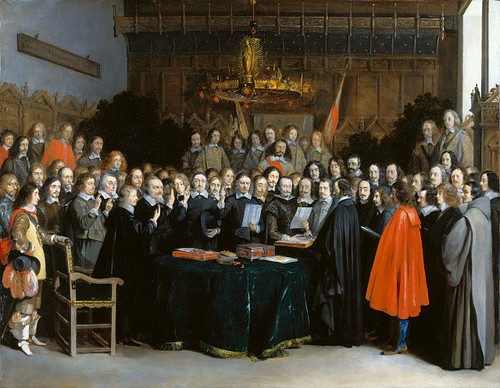
The Eighty Years' War broke Spain's power in the Low Countries and divided the region into what eventually became the Netherlands in the north and the countries of Belgium and Luxembourg in the south. The establishment of the Dutch East India and Dutch West India companies placed the Netherlands among the leading European powers in the 17th century participating in the Transatlantic Slave Trade, commercial trading, and the colonization of the Americas, West Africa, and the Caribbean among other areas.
The final legacy of the war continues to be debated as whatever good came out of it must be weighed against the enormous loss of life – before, during, and after – and the widespread destruction caused by people unwilling to compromise or simply leave each other alone. Whether in the case of the Habsburg kings of Spain and the Netherlands generally or between Protestants and Catholics, one Protestant sect against another, or divisions within a single sect, there were multiple times in the over 100 years of conflict when peace might have been possible without the demonization, by all involved, of those who held different beliefs and values.
